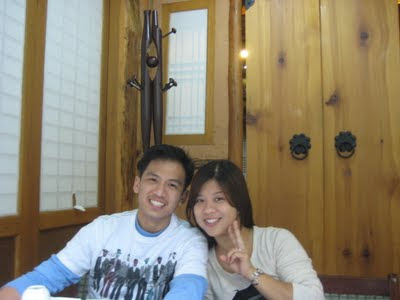Korean Food/Drink Culture
Last week I read a page on Korean food customs (식사 예절) for my language reading/writing class. Ever since I started my first meal in Korea I have been constantly bombarded with "do this" and "don't do that"s which made me feel extremely frustrated as I am a person who doesn't care much for formalities. But as time passes and I stay longer here in this country, I am starting to appreciate that it is all part of the unique culture that Koreans have. Through their education system and family values, these traditions and habits have been passed down from generation to generation and are deeply ingrained in their culture, no matter how modern Korean society progresses.
So, here are some of my observations and what I've learnt of Korean food/drink culture. ^^
 |
| With my in-laws - Visiting a traditional Korean meal 'hanjeongsik' near my university |
 |
| Hanjeongsik which consist of more than 20 side dishes!!! |
As everybody knows, a typical Korean meal consists of a main dish and many small side dishes known as panchan. A friend told me that when he was studying in Korea he was so poor that he could only afford to order plain rice (공기밥) and still the panchan would be served! And all the panchan are refillable! Haha...
A Korean lunch would normally cost around 5,000 won and dinner around 8,000 won. I usually skip breakfast as I can't manage to lug myself out of bed but there are these beautiful breadshops Paris Baguette and Tous les Jour which I can buy my sandwiches and milk from.
Utensils
At the table, Koreans use a long spoon (숟가락), chopsticks (젓가락) and bowl (그릇) for rice. The difference between Korean and Chinese culture is that the Korean utensils are all metal while the Chinese use bamboo chopsticks. The Korean chopsticks are unique in the sense that they are flat, which makes them more difficult to handle than Chinese chopsticks... therefore makes for a good souvenir back home! The metal rice bowl is kinda weird cos Chinese feel that it is like a beggar bowl...... Koreans also use chopsticks to eat birthday cake, which is one of the strangest habits I have ever seen!
When eating, it is considered good manners to use only one hand at a time. For example, you use a spoon for your soup, then put it down and pick up the chopsticks to take your rice or meat or vege, then put down the chopsticks again to use the spoon. It is considered bad manners to use both hands together while eating, especially in front of elders such as your professor. It is also bad manners to lift up the rice bowl while eating, which is different from Chinese and Japanese culture. The wet napkin is used to sanitize your hands first before eating, which is different from Malaysian culture where we wipe our hands and mouth after the meal.
In the Korean military, soliders use a single utensil known as the spoon-fork, which is essentially a spoon which has fork teeth at the end of the ladle. This eating device was designed to help the soldiers save precious time by not having to switch between spoon/chopsticks during the event of a war.
And don't even get me started on the ubiquitous paper cup - Koreans use the paper cup for coffee, to eat ramyeon during picnic, to hold candy, to hold electronic chips and resistors in the lab, and as I improvise, a lampshade for my LED project!
Before the meal
Koreans like to sit down at a low table on a cushion during dining, which can make your legs cramp! After everybody sits down, the most junior person at the table is expected to serve everyone by pouring out the water in the plastic flask, and distributing out the spoon, chopstick and napkins. One good thing for travelers to Korea is plain water is always given free - at restaurants, at department stores, at parks, at visitor centers etc... which is different from Japan.
During the meal
Age is important in Korea, therefore the most senior in the group will start the meal first by lifting his chopsticks and taking food, then all others will follow. It is considered good manners to utter a few words of "Eat well" (mashike duseyo) and this will usually gain you a few good points with your Korean professor especially if you are a new student hahaha...
There are a few types of soup in Korea - jigae(찌개), guk(국) and tang(탕). I'm not sure about their cooking methods (jigae is more instant, guk and tang typically take longer hours to boil) but jigae (for example doenjang jigae & kimchi jigae) are meant for sharing among a group of people, while guk and tang are for single servings. If you eat Korean BBQ meat (samgyupsal), rice and a bowl of steaming hot doenjang jigae is served after you have eaten almost all the meat. (Which my hubby, family and Malaysian friends are not used to and screaming hungry while eating the plain meat!! LOL...)
There are a few types of soup in Korea - jigae(찌개), guk(국) and tang(탕). I'm not sure about their cooking methods (jigae is more instant, guk and tang typically take longer hours to boil) but jigae (for example doenjang jigae & kimchi jigae) are meant for sharing among a group of people, while guk and tang are for single servings. If you eat Korean BBQ meat (samgyupsal), rice and a bowl of steaming hot doenjang jigae is served after you have eaten almost all the meat. (Which my hubby, family and Malaysian friends are not used to and screaming hungry while eating the plain meat!! LOL...)
When alcohol is served, Koreans believe that it is bad luck to pour alcohol for oneself, therefore they must always need to pour for each other. (Screams weird!!!) My hubby was so cute to ask, "Then Koreans cannot drink alone? Must ask waiter to pour for them?" When downing the drink, the most junior in the group will need to turn sideways and shield his face from the group, then drink from the cup, as to not bring bad luck to the group.
Before the most senior in the group had finished eating, no one is supposed to leave the table. OMG, I wonder how many faux pas have I done by going to the washroom in the middle of a meal with my professor!
#####
Does that sound like a lot to you? Do let me know... haha cos till now I still can't digest all of that.
Our assignment for the Korean class was to write about our country's eating customs. So I wrote that Malaysians normally use spoon and fork and the Chinese use chopsticks to eat and sometimes we use our hands to eat nasi lemak but we never ever use our left hand cos that's what we use to clean our ass in the toilet... then I asked my Korean friend to check my essay for me. And he was like... "But that's not eating custom! Eating custom is like elder eat first, junior follow... etc" How I wished to tell him that... other than the "don't use your left hand" rule, we Malaysians really have no eating rules and regulations! @.@...............
OK lah... till next time ^^
 |
| Me & my lovely hubby in November 2010 |
 |
| If I were ever to be a food columnist I would probably use this photo ^^ |
Location: near Pukyong/Kyungsung subway, past Body Shop
051-6236807
051-6236611
051-6236807
051-6236611

Comments